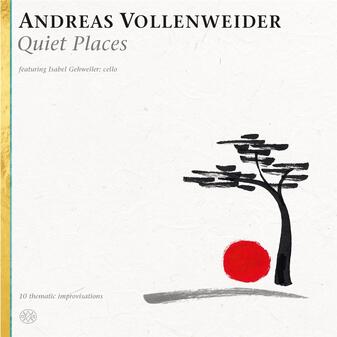
At the age of 22, he discovered a passion for the harp and, though he is gifted and proficient in piano, wind instruments, and percussion, it is the harp that has set him apart from so many other artists of our time. He has developed a style and approach unique to himself and has event crafted the instrument to his own liking. The results have been over 40 years of astonishing beauty and thought.
Andreas’ last release was 2009’s Air, an album of unabashed beauty. Releasing albums at a solid pace since 1979, this decade-long pause has been excruciating for those of us who love his music so much.
Again, it is worth the wait. The great news is that Quiet Places is part one of three new albums. Part two will be Slow Flow and part three will be Dancer. Andreas has also written his first novel, Reflection of Venus. Our idol has not been idle.
On Quiet Places, Andreas teams up with cellist Isabel Gehweiler and drummer/percussionist Walter Keiser. Keiser first played with Andreas in 1981. The 1981 album Behind the Gardens (with Keiser on drums) was my first step into the Vollenweider realm of wonder.
The culmination of this teaming of Andreas, Isabel and Walter are beyond tranquil. This album is a pilgrimage into recollection and imagination, emotion and thought.
The album opens with Pygmalion. Pygmalion was both king and sculptor in Greek mythology. The story is that he created a statue of a woman so beautiful that he fell in love with the statue. Isabel Gehweiler’s cello carries the mournful melody against Andreas’ pensive, reflective harp; her tragedy of unattainability against his hope of love. The piece summons reminiscences of plans gone awry, if not astray.
Polyhymnia is the muse of sacred poetry in Greek mythology. Indeed, Andreas and Isabel create their own sacred hymn of love of creation and the beauty of the world we see. The ascendant theme creates a work of enlightened joy and an expression of gratitude for all that is.
The Pyramidians follows next with a deliberate motion set by Andreas’ harp with Isabel’s cello playing low. The mathematical advances call forth images of ancient architects with their visions of height and splendor. Andreas’ recreates the warm and imaginative sounds that have set him apart for decades.
Following that is Entangled which opens with Andreas on the piano and features Isabel again on the cello. The gorgeous and reverential tones put one in mind of Debussy’s prelude La Cathédrale engloutie. Those numinous chords and the melodic fantasies are mesmerizing and inspiring.
Come to the Quiet Place is an invitation to contemplation. With Isabel’s cello and Walter on the drums, Andreas calls from deep to the deep with is ever-so-soft vocalizations. The synthesis of vocal tonality, harp strumming, bowing of the cello, and percussive drive are compelling.
Venus in the Mirror opens with the beautiful tremolo of Isabel followed by the delicate touch of Andreas. The intoxicating beauty of Venus is matched only by her reflection. That same beauty is reflected between Andreas and Isabel.
Bella Smiling is almost a ballad with drummer Walter Keiser as the only accompanist with Andreas. It is a beautiful melodic line with dynamic runs from Andreas. Andreas sings or intones softly, adding to the theme. I don’t know who Bella is but she must be adorable. The melody is playful and delicate, full of hope and joy. Listen for the indiscernible lyrics to put a smile on your own face.
Wanderungen (Hikes) features Andreas on the piano and Isabel on the cello, again. The wandering motifs and tones invoke visions of open vistas and running water. The piano yields beautifully, soulfully, to Andreas’ touch and the emotions that well up are both warm and sometimes melancholy. But the feeling of gratitude is never far away.
Sculpture features Isabel and Walter and opens with a bowing of the cello and beat of the snare that lay beautiful groundwork for Andreas’ airy tones. Isabel’s droning cello draws memories of the Mongolian band The Hu. Then come the East Asian motifs that absolutely transport the listener. An extraordinary piece.
The album closes with Fields of Blue. The melody is almost liturgical and the spiritual flights of the harp with the groundedness of the cello is something nothing short of rapturous. Then the duo takes off into a Middle Eastern interlude before returning to the warmth and wonder of the theme.
The performances on the album are nothing short of flawless. That was to be expected. And the improvisations also what we have come to love and admire and even expect. But it is not expectation that accompanies the loveliness of Andreas Vollenweider—it is expectancy. The expectancy that comes from faith from what he has done before and the knowledge that something marvelous is about to happen.
Quiet Places was indeed worth the wait.
~Travis Rogers, Jr. is The Jazz Owl
 RSS Feed
RSS Feed
